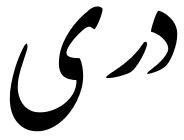Language/Dari/Grammar/Definite-and-Indefinite-Articles
| ◀️ Noun Gender and Plurals — Previous Lesson | Next Lesson — Family Members ▶️ |
Introduction
Welcome to the lesson on definite and indefinite articles in Dari! In this lesson, we will learn about the important role that articles play in sentence construction and how to use them correctly.
As a beginner, you might feel overwhelmed with so many new concepts to learn. Fear not, with the help of cultural information and interesting facts, we will make your learning journey enjoyable and engaging.
Let's dive into the world of definite and indefinite articles in Dari!
With the completion of this lesson, consider investigating these related pages: Nouns & Personal Pronouns.
Definite Articles
A definite article (تعریفی مضاف) is a word that specifies a particular noun. In Dari, the definite article is "ی". It corresponds to the English word "the."
Here are some examples:
| Dari | Pronunciation | English |
|---|---|---|
| میز ی | miz-e | the table |
| کتاب ی | ketāb-e | the book |
| مردی که دیدم ی پیر بود | mardi ke didam-e pir bud | the man I saw was old |
| داری ی بیابان با دوست داشتنی ست | dāri-ye biaabān bā dustdāshtani-st | the house in the desert is lovable |
As you can see from the examples, the definite article "ی" comes at the end of the noun it specifies.
Indefinite Articles
An indefinite article (تعریفی نامضمون) is a word that refers to any member of a general class of people, places, or things. In Dari, the indefinite article is "یک". It corresponds to the English word "a" or "an."
Here are some examples:
| Dari | Pronunciation | English |
|---|---|---|
| یک میز | yak miz | a table |
| یک کتاب | yek ketāb | a book |
| یک مرد ست | yek mard hast | there is a man |
| یک داری در گلستان | yek dāri dar golostān | a house in the garden |
As you can see from the examples, the indefinite article "یک" comes before the noun it specifies.
Null Articles
In some cases, neither a definite nor an indefinite article is used in Dari. This is known as the null article.
Here are some examples:
- او از حمام خارج شد. (U az hamām khārij shod.) - He left the bathroom.
- شاهین شیر نوزاد را میدوید. (Shāhin shir-e nowzād rā midavid) - The falcon feeds its baby lion.
In both examples, there are no articles used before the nouns "حمام" (hamām) and "شیر" (shir), respectively. This is because the context is clear enough to specify what specific object is being referred to.
Cultural Information
Dari, also known as Afghan Persian, is one of the two official languages of Afghanistan, along with Pashto. It is a variety of Persian spoken in Afghanistan and is the native language of around 25% of the population.
Persian, including Dari, has a long history of literature, poetry, and culture. It is considered as one of the world's oldest and richest written traditions, with a legacy dating back over a thousand years. Many famous poets, such as Rumi and Hafez, have written some of their works in Persian.
Interesting Facts
- The Taj Mahal, one of the most famous landmarks in India, was built by a Persian architect, Ustad Ahmad Lahauri, who was originally from Iran but had settled in India. - Persian is an important liturgical language for Zoroastrians, Baha'is, and other religious communities. - Persian cuisine is known for its rich flavors and use of fresh herbs. Some popular dishes include kebab, kashk-e bademjan, and ghormeh sabzi.
Conclusion
In this lesson, we learned about the different types of articles in Dari: definite, indefinite, and null articles. We also explored examples of each type and their role in sentence construction.
By incorporating cultural information and interesting facts, we hope to make your learning experience fun and engaging. Keep practicing, and you'll soon be a master in using articles in Dari!
Now that you've completed this lesson, don't stop learning! Check out these related topics: Give your Opinion & Noun Gender and Plurals.
Other Lessons
- Asking Questions
- Personal Pronouns
- Nouns
- How to Use Have
- Comparatives and Superlatives
- Questions
- How to Use Be
- Give your Opinion
- Basic Prepositions
- Adverbs
Sources
| ◀️ Noun Gender and Plurals — Previous Lesson | Next Lesson — Family Members ▶️ |

